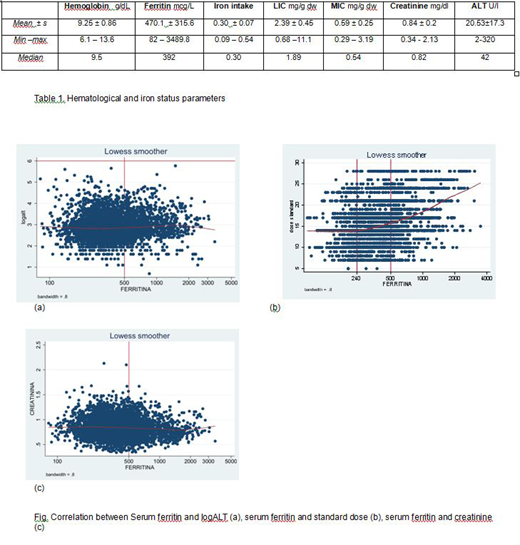
Introduction
The current therapeutic management of transfusion dependent thalassemia (TDT) is based on regular blood transfusion and iron chelation therapy. Transfusion iron overload remains one of the major causes of morbidity and mortality in these patients because of the accumulation in heart, liver and endocrine glands. Three iron chelators are available in clinical practice: deferoxamine (DFO), deferiprone(DFP) and deferasirox (DFX). Guidelines clearly recommend when to start iron chelation, while discontinuation criteria are not well defined. Authorised product information state that we should consider interrupting DFX if serum ferritin (SF) falls consistently below 500mcg/L. This cut off was arbitrarily determined and there are no studies evaluating the effects of chelators in presence of SF below 500 mcg/L. In our clinical practice at Rare Diseases center of Fondazione IRCCS Ca' Granda Policlinico in Milan we do not completely interrupt iron chelation in TDT patients for SF levels below 500 mcg/L.
Aims and methods
Aim of our study was to evaluate the appearance of adverse events due to the assumption of iron chelation therapy in those TDT patients who had SF below 500 mcg/L. In this study we retrospectively evaluated renal and liver function from 2008 throughout December 2018 in TDT patients on DFX who presented SF below 500 mcg/L for 24 consecutive months. DFX dose are all expressed with the new tablets formulation dose. We evaluated SF, iron intake, LIC and MIC, renal and hepatic function. .A total of 5076 observations were collected, with 99.5 average per patient. We evaluated the relationships among variables with correlation models with random intercept
Results
One hundred ninety-two TDT patients are regularly followed at our center. They receive regular transfusion treatment and iron chelation therapy to prevent secondary iron overload. 51 out of 192 patients (32 F, 19 M, aged 44 ± 7 years) treated with DFX presented mean SF below 500 mcg/L for at least 24 consecutive months. Hematological and iron status parameters are described in Table 1. We found a strong correlation between SF and LIC (p<0.001) and for SF<500 mcg/L no hepatic iron overload was observed. Conversely we did not found a correlation between SF and MIC.
For SF values below 500 mcg/L there was a minimal increase in creatinine levels, however the mean creatinine values remained within the normal range.Moreover, creatinine variation between two consecutive evaluation was below 0.3 mg/dl, cut off for acute kidney injury.
Similar results were observed for liver function. Although a minimal increase of mean ALT value was observed for SF below 500 mcg/L, it remained within the normal range. None of our patient showed ALT level indicative of liver damage (ALT> 10 x upper limit of normal)
We evaluated the relation between SF and DFX dose. Mean DFX dose decreases according to SF reduction. However, for SF value < 240 mcg/L, DFX dose remained stable at an average of 14 mg/kg per day.
Conclusion
According to our preliminary data, administration of DFX in TDT patients in presence of SF below 500 mcg/L is safe. Creatinine and ALT fluctuations, that usually remain within the range of normality, are mild, and transient and do not require specific treatment. Consistently with previously published data by Cohen et al, we show that a mean dosage of DFX of 14 mg/Kg die of film-coated tablet (20 mg/Kg of dispersable formulation) are necessary to balance an iron intake of 0.3 mg/kg die in absence of iron overload. Based on these results we suggest that in TDT patients with a continuous iron intake, iron chelation should be continued even when ferritin is below 500mcg/L. Monitoring of liver and kidney function tests are recommended in patient's follow up, as well as tailoring iron chelation.
Cappellini:Vifor Pharmaceutical: Membership on an entity's Board of Directors or advisory committees; CRISPR Therapeutics: Membership on an entity's Board of Directors or advisory committees; Celgene Corporation: Honoraria; Novartis: Membership on an entity's Board of Directors or advisory committees; Genzyme/Sanofi: Honoraria, Membership on an entity's Board of Directors or advisory committees. Motta:Sanofi-Genzyme: Honoraria, Membership on an entity's Board of Directors or advisory committees.
Author notes
Asterisk with author names denotes non-ASH members.

This icon denotes a clinically relevant abstract


This feature is available to Subscribers Only
Sign In or Create an Account Close Modal